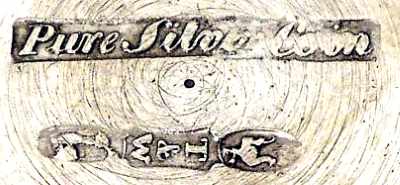|
WHITING MANUFACTURING COMPANY
|
This is a page of A
Small Collection of Antique Silver and Objects of vertu,
a 1000 pages richly illustrated website offering all you
need to know about antique silver, sterling silver,
silverplate, sheffield plate, electroplate silver,
silverware, flatware, tea services and tea complements,
marks and hallmarks, articles, books, auction catalogs,
famous silversmiths (Tiffany, Gorham, Jensen, Elkington,
WMF, Reed & Barton, Mappin & Webb, Bateman Family),
history, oddities ...
SITE MAP
HOME PAGE
|
HISTORY AND MARKS
Whiting Manufacturing Co traces its origin to the firm Tifft & Whiting formed in 1840 by Albert C. Tifft and William Dean Whiting.
After the retirement of Tifft the firm changed to Whiting & Gooding (& Co) in 1853, Whiting Fessenden & Cowan (1858), Tifft Whiting & Co (1859, re-entering of Tifft), Whiting Cowan & Bowen (1864) until its forming as Whiting Manufacturing Co in 1866.
The factory, located in North Attleboro, Massachusetts, was destroyed by a fire in 1875. What was salvaged by the ruins was acquired by F, Jones and the production transferred to New York combining its manufacturing operations and offices into one building at 692-694 Broadway at Fourth Street.
The company was purchased by Gorham in 1924 and the production transferred to Providence, Rhode Island.
Whiting had relatively small production output but produced exceptional handmade silverware in relatively small quantities.
The Company's most famous and important designer was Charles Osborne. In the 1880's he worked for Tiffany for a period of time before returning to Whiting. His designs are some of the most important of the American aesthetic movement.
From 1905 to 1924 the firm marked its production with date symbols.
Whiting was absorded by Gorham in 1926.
CHRONOLOGY
Tifft & Whiting 1840-1853
Whiting & Gooding (& Co) 1853 - 1858
Whiting, Fessenden & Cowan 1858 - 1859
Tifft, Whiting & Co 1859 - 1864
Whiting, Cowan & Bowen 1864 - 1866
Whiting Manufacturing Co 1866 - 1924
absorbed by Gorham 1926
|


|
|
Tifft & Whiting mark
|

|
|
Tifft & Whiting & Co mark
|


|
|
Whiting Manufacturing Co mark on holloware
|


|
|
Whiting Manufacturing Co mark on flatware
|
DATING WHITING SILVER BY CONSTRUCTION NUMBER (1880-1894)
Beginning about 1880, Whiting stamped its hollowware with a sequential number, essentially a design number,
allowing the designs and objects to be systematically tracked. The objects were marked also with a letter (A through Z) apparently indicating an alternative ornamental scheme.
DATE STAMP DESIGN NUMBER
1880 unknown -
1881 unknown -
1882 unknown -
1883 1000-1341 341
1884 1342-1623 281
1885 1624-1951 327
1886 1953-2317 364
1887 2318-2648 330
1888 2649-2940 291
1889 2941-3231 290
1890 3232-3465 233
1891 3466-3827 361
1892 3828-4050 222
1893 4051-4332 281
1894 4333-4740 407
|
WHITING MANUFACTURING CO YEAR MARK (1905-1924)
|
WHITING MANUFACTURING CO FLATWARE PATTERNS
Whiting manufactured a wide array of flatware patterns, of its own design or using the acquired dies of Michael Gimney and Henry Hebbard.
The list of flatware patterns manufactured by Whiting Mfg Co comprises:
Adam (1907), Alhambra (1880 photo 1), Antique-Chased (1882), Antique Lily-Engraved (1882), Antique Rosette (1880), Arabesque (1875 photo 2), Armor (1871), Athenian (1890), Bead (1880), Berry (1880), Burlington (1914), Chateau (1923), Colonial (1907), Cox 1850), Dandelion (1890), Diamond (1880), Dorothy Vernon (1909), Dresden (1896), Duchess (1906), Duke of York (1900), Eastlake (1880), Egyptian (1875), Fairfield (1912), French Thread (1880), Fruit (1880), Gem Leaf (1880), Gibney (1862), Grape (1855), Grecian (1862 photo 3), Heraldic (1880 photo 9), Honeysuckle (1870), Hyperion (1888), Imperial Queen (1893), Indian (1874), Italian 1880) Ivy (1865), Japanese (1874), Jenny Lind (1920), Keystone (1888), King Albert (1919), King Edward (1901 photo 4), Lady Baltimore (1910), Laureate (1890), Le Cordon (1850), Lily (1870), Lily (1902,Lion, Pat 1902), Lily of the Valley (1885 photo 5), Livingston (1914), Louis XV (1891), Madam Jumel (1908), Madam Morris (1909), Mandarin (1918), Mask (1889), Newport (1917), Old King 1890), Oriana (1916), Oval Thread 1880), Oval Twist (1880), Persian (1880), Pompadour (1895 1898), Pompeian (1913), Portland (1913 1914), Prince Albert (1855 photo 6), Radiant (1895), Roses and Scrolls (circa 1890), Rosette (1890 photo 7), St. Martin's (1916), Stratford (1910), Stuart (1912), Violet (1905), Wedgwood (1910 photo 8)
1 Alhambra 2 Arabesque 3 Grecian 4 King Edward 5 Lily of the Valley 6 Prince Albert 7 Rosette 8 Wedgwood 9 Heraldic
|
| SILVERPLATE AND ELECTROPLATED SILVER OF USA AND CANADA
|
FIGURAL MARKS
anchors, animals, arrows, bells,
birds, candelabra, crosses, crowns
fantastical entities, horses
human figures, lions, musical instruments
plants and vegetables, stars swords axes blades,
tools, windmills, others |
| STERLING SILVER OF USA AND CANADA
|
| SILVER MANUFACTURERS: MARKS, HISTORY AND INFORMATION |

www.silvercollection.it |
This is a page of 'The What is? Silver Dictionary' of A Small Collection of
Antique Silver and Objects of vertu, a 1500 pages richly illustrated website offering all you need to know about
antique silver, sterling silver, silverplate, Sheffield plate, electroplate silver,
silverware, flatware, tea services and tea complements, marks and hallmarks, articles,
books, auction catalogs, famous silversmiths (Tiffany, Gorham, Jensen, Elkington),
history, oddities ...
HOME - SITE MAP - SILVER DICTIONARY - COOKIES CONSENT AND PRIVACY |
|
|